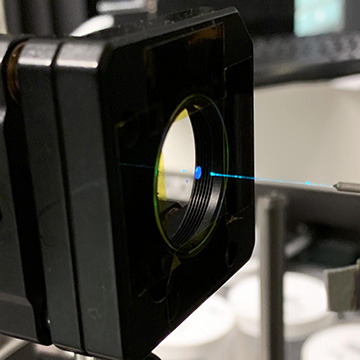
The AR imaging result using the full-color near-eye fiber scanning display, which shows an RGB-color virtual image floating in a real-world scene. [Image: Zhaoyi Li/Harvard University]
In the 1950s, U.S. filmmaker Morton Heilig designed a single-person, multisensory theater with a color stereoscopic display, fans to mimic wind, stereophonic sound and even odor emitters for full immersion. The Sensorama, as he called it, failed to receive financial backing but remains one of the earliest examples of virtual reality (VR) technology.
Today, VR has evolved to a point where commercially available devices are regularly used in entertainment, education, engineering and other industries. However, headsets are still relatively bulky in both size and weight due to the limitations posed by optical lenses, compromising the user’s comfort and viewing experience.
To solve this issue, a new study demonstrates an innovative VR system based on metalenses—essentially, flat surfaces patterned with nanostructures that focus light—measuring only two millimeters in diameter (Sci. Adv., doi: 10.1126/sciadv.abe4458).
The problem with virtual reality
The lab of OSA Fellow and 2021 Ferederic Ives Medal/Jarus W. Quinn Prize winner Federico Capasso, Harvard University, USA, has focused on the development of metasurfaces and flat optics for several years now. Recently, an industrial researcher in the field of virtual and augmented reality (AR) approached Capasso and his colleagues with a problem. He wanted to replace the refractive eye-pieces in VR headsets with thin, diffractive Fresnel lenses but found that the chromatic aberration was too strong, making it useless in imaging.
“We realized an opportunity of meta-optics in the fast-growing VR/AR market,” said Zhaoyi Li, a postdoctoral fellow in Capasso’s lab. “Though the question is very challenging, we see hope in the meta-optics based on its recent breakthroughs of physics, material platform and fabrication techniques.”
A principal advantage of meta-optics in general is that the phase, amplitude and polarization state of transmitted light can be manipulated with subwavelength resolution by choosing the shape of the elements and the way they are arranged within the structure. In this way, Li and his colleagues were able to design a multizone dispersion-engineered metalens that achieves controlled focusing at different frequencies of light and eliminates chromatic aberration.
Putting the metalens to the test

The flat lens VR system setup features a metalens fabricated on 2-inch glass wafer (left) and a scanning fiber mounted through a piezo tube (right). [Image: Zhaoyi Li/Harvard University]
The researchers first validated their design with simulations and theoretical study before fabricating the device. The metalens was composed of titanium dioxide nanofin structures fabricated on a silica substrate with electron beam lithography and atomic layer deposition, and etching. Experiments to measure its performance showed nearly ideal focusing that was both achromatic and diffraction limited.
Finally, Li and his colleagues put the metalens to the test in a VR/AR demonstration. In a VR/AR headset, a lens is placed in front of the eye with a display located within the focal plan of the lens, causing the eye to see virtual images that appear further away. The researchers employed a home-built, near-eye fiber scanning display with high resolution, brightness and dynamic range with a camera to capture the virtual images. The results revealed relatively uniform light-intensity distribution and reasonably high image resolution.
A bright future for meta-optics
While optical lenses have kept roughly the same form factor for thousands of years, metalenses have the potential to set a new standard by replacing conventional pieces with optically thin, lightweight and achromatic components. Next, the researchers plan to further increase the size of the dispersion-engineered meta-optics to centimeter scale and integrate them with a commercial VR/AR platform for prototyping.
“We foresee that meta-optics can be readily used in VR/AR headsets in the future. In addition, the fiber scanning techniques demonstrated in this work is not only useful for a near-eye display but also for an eye-tracking system,” said Li. “The meta-optics may also find important applications in consumer electronics, such as cellphone lenses.”
